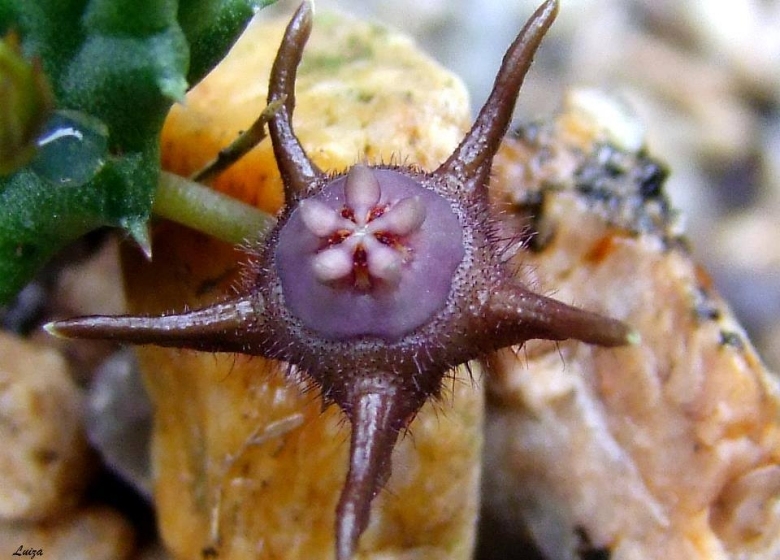




Your support is critical to our success.

Origin and Habitat: Republic of South Africa (Eastern Cape).
Habitat and ecology: The same area harbours many other succulents such as Haworthia cooperiSN|13690]]SN|14982]], Haworthia nigraSN|14982]]SN|13690]], Euphorbia tridentata, Stapelia miscella and various Senecios.
Synonyms:
- Duvalia modesta N.E.Br.
ENGLISH: Modest duvalia, Unassuming duvalia
Description: The "modest duvalia" or "unassuming duvalia" (Duvalia modestaSN|30447]]SN|30447]]), is a mat-forming, perennial-succulent, with briefly egg-shaped stems with 4 to 5 indistinctly hooked ribs. The dark chocolate petals of D. modesta are bent backward for one-half their lengths, bent into a hook and have their edges fringed with purple hairs. The flowers, two to tree occur in the middle of the younger stems. The annulus is naked; the coronal disk is bluntly pentagonal and flesh colored.
Derivation of specific name: We can only assume that this plant was called the 'unassuming duvalia' because of the smallness of its flowers which are about 1.5 cm across, (modesta meaning 'unassuming') .
Stems: Delicate, 12-40 (or more under cultivation) mm long, 8-12(-20) mm thick, ovoid or oblong (to cylindrical), with 4–5 obtuse tuberculate-toothed angles, glabrous, dark green.
Leaves: Rudimentary 1.5 mm long, stipular glands small, some-times absent.
Flowers: 2–3 (or more) together at the middle of the young stems, procumbent, developing successively with slight foetid odour. Pedicels 8-20 mm long, glabrous. Sepals 2-4 mm long, lanceolate, acute, glabrous. Corolla 12-25 mm in diameter, dark chocolate to brownish-purple. Corolla lobes 5-9 mm long, 3-6 mm wide, with the margins closely replicate at the apical half and reflexed-spreading at the basal part, ovate when flattened out, acuminate, margins ciliate for half of their length with soft fine, often curved, simple purple hairs 1-2,5 mm long, otherwise quite glabrous. Annulus about 5-8 mm in diameter, 1-1.5 mm high, circular or obtusely pentagonal, glabrous, rim papillose, hairy papillae 0.05 - 0.1 mm long. Corona ivory, maroon, brown to dark purple, disc 3-5.5 mm in diameter, obtusely pentagonal, mostly dark reddish-brown. Inner corona-lobes 1-2 x 1-1.5 mm mostly reddish. Pollinia 0.3 x 0.2 mm.
Fruits (paired follicles): 8 - 13 cm long, fusiform.
Seeds:* 4x 2.5 mm.
Bibliography: Major references and further lectures:
1) N. E. Brown “Flora Capensis”, Vol 4, 1909
2) Werner Rauh “The Wonderful World of Succulents: Cultivation and Description of Selected Succulent Plants Other Than Cacti” Smithsonian Institution Press, 1984
3) Focke Albers, Ulrich Meve “Illustrated Handbook of Succulent Plants: Asclepiadaceae: Asclepiadaceae” Volume 4 Springer, 2002
4) Bruyns, P.V. “Stapeliads of southern Africa and Madagascar.” (Vol. 1, pp. 1-330). Umdaus Press, Pretoria.2005
5) Thomas H. Everett “The New York Botanical Garden Illustrated Encyclopedia of Horticulture”, Volume 4 Courier Corporation, 01 January 1981
6) “Bradleya: Yearbook of the British Cactus and Succulent Society”, Volumes 1-5 The Society, 1983
7) Margaret J. Martin, Peter Richard Chapman “Succulents and their cultivation” Scribner, 1978
Cultivation and Propagation: Duvalia modestaSN|30447]]SN|30447]] is an easy obliging blooming plant when mature, that it is happy in any average succulent house.
Potting:Since roots are quite shallow, use a soft and incoherent cactus mix or add extra perlite or pumice to regular soil potting soil, and clay pots help the plants to dry out between watering.
Waterings: Duvalia require moderately watering through the growing season but enjoy plenty of water and some fertiliser in hot weather, this helps them to flower freely. Water more sparingly in winter according to temperatures. But, as with most asclepiads, it is unwise to leave them wet in cold weather.
Fertilization: Fertilizers for succulent plants must be rich in potassium, but poor in nitrogen, to avoid the plants from developing excess vegetation, which is easily attacked by fungal diseases.
Sun Exposure: As with many succulents, they prefer to grow in the light shade of scrubby shrubs or between rocks where they get some shade during the day. In summer it is advisable to position this plant in a partially shady place, where it is exposed to direct sunlight only during the coolest hours of the day.
Hardiness: These plants don't like cold weather, therefore in the Spring it is best to set them outside only when the temperatures are above 15°C. Can endure temperatures below 5°C for short period, but only if the soil stays completely dry.
Pest and diseases: Duvalias vary in their susceptibility to rotting, but are generally fairly easy to grow, especially if kept pest-free. They are very susceptible to stem and root mealy bugs, and damage from these may well initiate fungal attack. If you do have problems with a stem or with basal rotting, you can reliably isolate the healthy parts, dry them off, and re-root them in moist compost.
Cultural Practices: Re-pot every 2 years.
Propagation: Easiest with stem cuttings. Allow cuttings to dry a day before planting. Stems must be laid (Not buried) on gritty compost and will then root from the underside of the stems. It can also be increased from seeds sowing in spring in moist, sandy peat moss. Barely cover seeds. Seeds germinate quickly.
| Your Actions | |
|---|---|
| Back to Duvalia index | |
| Back to Asclepiadaceae index | |
 |
Back to Succulents Encyclopedia index |
Privacy stantement - Terms and conditions - How to cite - About us - Feedback - Donate



